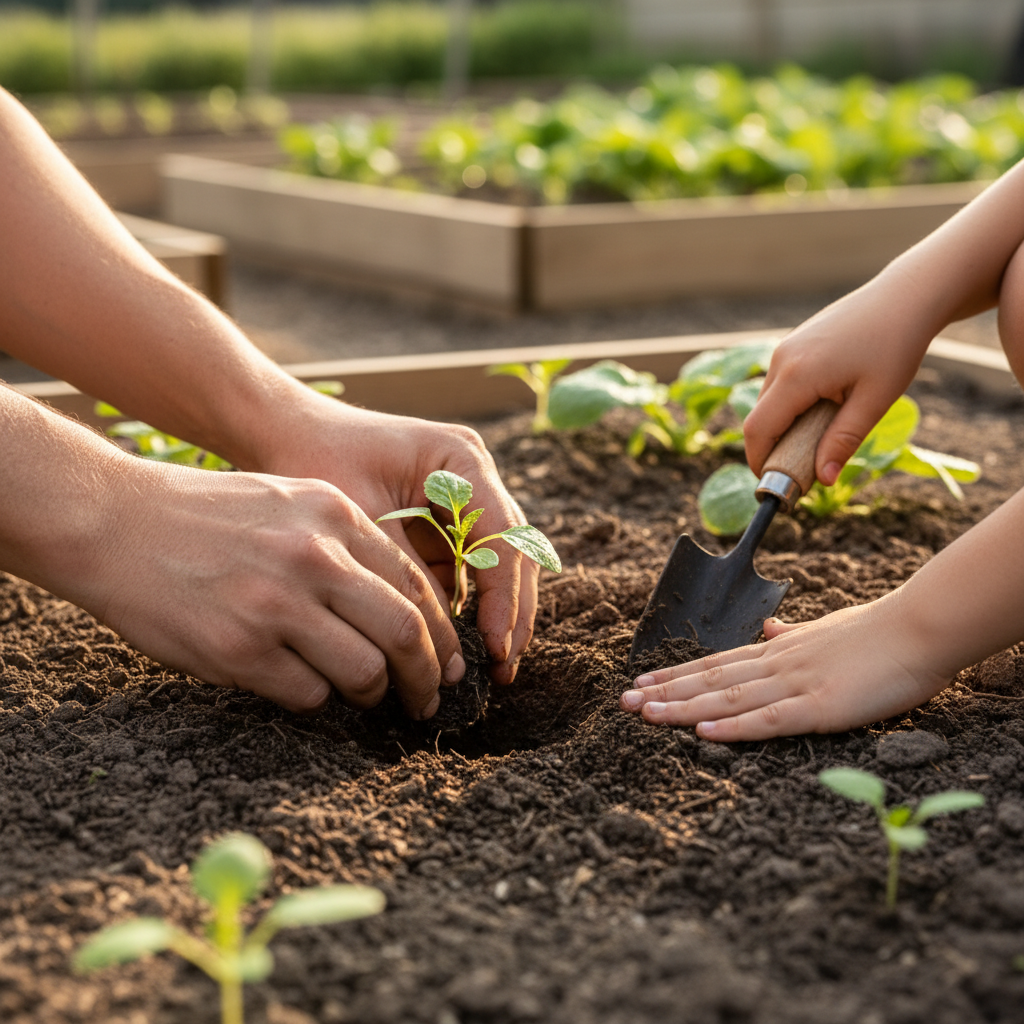
Table of Contents
Introduction
Imagine transforming a vacant lot in your neighborhood into a vibrant, green oasis where neighbors come together to grow fresh vegetables, beautiful flowers, and build lasting connections. Community gardens are more than just patches of cultivated soil; they are powerful spaces that foster community spirit, promote sustainability, and improve the quality of life for individuals and families alike. Whether you dream of growing your own food, beautifying your surroundings, or creating educational opportunities, starting a community garden offers a fulfilling path to achieve these goals.
In recent years, the popularity of community gardens has grown rapidly, driven by increased awareness of environmental issues, the desire for healthy, local food, and the need for stronger community bonds. According to the American Community Gardening Association, there are over 18,000 active community gardens in the United States alone, serving as hubs of environmental stewardship, social inclusion, and urban renewal. These gardens not only provide fresh produce but also offer a place for physical activity, mental well-being, and learning. In urban areas especially, where green space can be limited, community gardens act as vital green lungs that improve air quality and reduce the urban heat island effect.
Starting a community garden, however, is not without its challenges. It requires thoughtful planning, securing resources, and engaging the community meaningfully. Many people worry about where to begin, how to garner support, and what kind of garden will best serve their neighborhood’s needs. Addressing these concerns early on can set the stage for a successful and sustainable project. To help, this guide breaks down the essential steps and considerations for launching a community garden from scratch, making the process approachable and manageable for anyone passionate about green living.
Furthermore, community gardens serve as educational platforms that teach gardening skills, nutrition, and environmental responsibility. They can inspire people of all ages to reconnect with nature, understand where their food comes from, and adopt healthier habits. Through shared responsibility and collaboration, these gardens nurture a sense of ownership and pride, which contributes to safer, more resilient neighborhoods. If you’re new to gardening, various resources offer beginner-friendly advice, such as gardening tips for beginners, which can provide a solid foundation to get started with confidence.
What You’ll Learn in This Guide
This guide will walk you through the entire journey of starting a community garden, providing practical insights and actionable steps. Here’s a preview of the key topics covered:
- Planning Your Garden: Learn how to choose the right type of garden, set clear goals and objectives, and develop a vision that aligns with the community’s needs and interests.
- Building Community Support: Discover strategies for recruiting volunteers, forming committees, and engaging local organizations to create a passionate and committed team.
- Securing Location and Resources: Understand how to assess and find suitable land, gather tools and supplies, and explore funding options such as grants and donations.
- Preparing and Maintaining the Garden: Follow best practices for site preparation, planting, watering, pest control, and organizing ongoing maintenance with community involvement to ensure long-term success.
Throughout this guide, you’ll gain insights into potential challenges and how to overcome them, from funding shortages to environmental factors. You’ll also find inspiration to foster connection, sustainability, and joy through shared green spaces. Whether you have a small plot or a large vacant lot to work with, this comprehensive resource aims to empower you to create a thriving community garden that benefits everyone involved.
Starting a community garden is more than just planting seeds—it’s about sowing the seeds of community spirit, wellness, and environmental care. We’ll delve into each step with detailed advice, real-world examples, and tips to keep your project sustainable and inclusive. You’ll learn how to build a garden that reflects your community’s unique character and meets its specific needs.
By the end of this guide, you will feel equipped with the knowledge and confidence needed to embark on this rewarding journey. Whether you want to grow fresh food, create a beautiful space, or bring people together, a community garden is a powerful catalyst for positive change. Let’s get started on cultivating a greener, healthier, and more connected community together.

Building on the foundational benefits and overview of community gardens introduced earlier, it is essential to delve into the practical steps and considerations that bring these green spaces to life. Starting a community garden is a rewarding endeavor that fosters neighborhood connectivity, environmental stewardship, and sustainable food production. However, successful implementation requires thoughtful planning and wide community involvement. This discussion will explore two crucial phases: planning your community garden and engaging the community for sustained support and growth. Understanding these facets will equip you with the tools necessary to transform an idea into a thriving, vibrant garden that enriches your neighborhood for years to come.
Planning Your Community Garden
Effective planning forms the backbone of any successful community garden. This phase is about translating your vision into actionable goals that align with the needs and interests of your community. It starts with deciding the primary purpose of the garden—whether it’s to grow vegetables for food security, cultivate ornamental flowers for beautification, or create a mixed-use space serving multiple objectives. Consideration of these factors helps set clear expectations and guides subsequent decisions about location, resources, and management.
Creating a comprehensive plan also involves establishing specific objectives such as community engagement or educational outreach, which enrich the garden’s impact. Engaging early with potential garden members and local stakeholders provides valuable input that shapes these goals realistically and inclusively, ensuring the garden becomes a shared asset.
Moreover, assessing your resources and constraints during the planning stage is critical. Understanding budget limitations, availability of volunteers, and access to gardening tools helps tailor your approach to existing capacities. It is equally important to consider future scalability and maintenance plans to ensure longevity. Detailed planning might also include exploring local regulations, securing permissions, and identifying grant opportunities to support financial needs. To fully grasp these concepts, it helps to review essential gardening tips for beginners, which provide foundational knowledge for new gardeners embarking on community projects.
Key Aspects of Planning Your Community Garden
Here are the fundamental components to focus on during the planning phase:
- Choosing the Right Type of Garden: Decide between vegetable, flower, or mixed-use gardens based on community preferences and environmental conditions. A vegetable garden supports food production and nutrition, while flower gardens enhance aesthetic appeal and local biodiversity. Mixed-use gardens combine both benefits but may require more complex management.
- Setting Goals and Objectives: Define clear purposes such as fostering community involvement, providing educational programs about sustainability and gardening, or increasing access to fresh produce. Clarity here helps steer efforts and measure success effectively.
- Resource and Site Assessment: Evaluate available space, soil quality, water access, and sunlight exposure. Early identification of these factors prevents future challenges. Also, consider necessary tools, materials, and potential funding sources to support garden establishment and maintenance.
- Building Partnerships: Engage with local organizations, schools, and municipal bodies early to secure support, permissions, and resources. These collaborations can amplify outreach, pool expertise, and secure funding or donations critical to the garden’s success.
Getting Community Support and Involvement
Once the initial planning groundwork is laid, cultivating strong community support is vital to the garden’s sustainability and vibrancy. Community involvement transforms the garden from a static project into a living, evolving space that meets diverse needs. Engaging a broad group of participants ensures shared ownership and responsibility, increasing the likelihood of long-term care and enthusiasm.
Building a dedicated team is an essential first step. This involves recruiting volunteers with varied skills—from gardening expertise and project management to outreach and fundraising capabilities. Forming committees can help distribute responsibilities efficiently and maintain momentum. In addition, connecting with local organizations, businesses, and schools creates a network of stakeholders who can provide ongoing support and resources.
Effective community outreach expands the garden’s visibility and draws in new participants. Hosting informational and planning meetings allows for input and establishes open communication channels. Leveraging social media platforms can attract younger audiences and keep the community updated on progress and events. Partnering with schools offers unique educational opportunities, integrating curriculum-based garden activities that engage students and families. Local businesses can sponsor events or donate supplies, fostering a collaborative spirit.
Together, these strategies build a resilient community around your garden project, fostering shared success and collective enjoyment. For a detailed breakdown of gathering volunteer help and stakeholder support, see our guide on gardening tips for beginners, which provides actionable advice on forming and sustaining garden teams.
Important Considerations for Community Involvement
Key elements to focus on when engaging community participation include:
- Recruiting Volunteers: Use clear communication about the garden’s goals and how individuals can contribute. Highlight the benefits of participation, such as skill development, social connections, and wellness improvements, to encourage involvement.
- Forming Committees: Establish specialized groups responsible for aspects like maintenance, events, fundraising, and education. This division of labor helps manage workload effectively and builds leadership capacity within the community.
- Engaging Local Organizations: Collaborate with nonprofits, civic groups, and educational institutions to gain diverse perspectives, expand resources, and increase outreach potential. Partnerships also lend credibility and facilitate access to grants or donations.
- Community Outreach Techniques: Host open meetings for transparency, maintain active social media engagement to reach wider audiences, and create partnerships with schools and businesses for mutually beneficial support and increased visibility.

Conclusion
Starting a community garden is a rewarding endeavor that brings numerous benefits to neighborhoods and individual participants alike. Throughout this guide, we’ve explored the essential steps needed to transform an open space into a thriving green hub. From carefully planning your garden’s type and goals to engaging community members and securing the right location and resources, each stage plays a vital role in building a sustainable and successful garden. A community garden is not only about cultivating plants but also about sowing connections and fostering a shared sense of purpose and pride among members.
Planning your garden effectively by choosing whether to focus on vegetables, flowers, or a mixed approach sets a clear direction. Equally important is setting meaningful objectives, whether it’s to promote food production, provide education, or encourage social interaction. Building a committed team through outreach and volunteer recruitment creates a foundation of support that sustains the project through challenges. Securing a suitable site with good soil and accessibility and gathering necessary tools and funding are key logistical steps that prepare the garden for growth.
Once your site is ready, planting with suitable species for your climate and soil conditions ensures a healthy start. Maintaining the garden with proper watering, weeding, pest control, and organizing community maintenance schedules keeps the garden productive and welcoming. Addressing common challenges such as funding shortfalls or security concerns with proactive strategies helps your garden remain resilient. Ultimately, a community garden is a continuously evolving space that reflects and strengthens the needs and spirit of those involved.
To take the next practical steps, begin by clearly defining the vision and goals specific to your community’s interests. Reach out actively to neighbors, local groups, and organizations to form a cooperative team passionate about the garden’s success. Seek potential locations, assessing factors like soil quality and ease of access, and explore funding options such as grants or donations. Starting small with manageable planting projects allows your team to learn and build momentum. Additionally, establish a regular maintenance plan with volunteer rotations and periodic community events to keep enthusiasm high and the garden thriving.
By embracing collaboration and careful planning, your community garden can flourish as a green oasis that provides fresh produce, educational opportunities, and a beautiful shared space. As you embark on this journey, remember that the garden’s vitality depends on ongoing engagement and care. Encourage community members to take ownership, celebrate achievements together, and welcome new participants. With dedication, your garden will grow not only plants but also friendship, resilience, and a deeper connection to nature and your neighborhood. Start sowing the seeds today for a healthier, more sustainable, and united community.
Frequently Asked Questions
-
What size space do I need for a community garden?
- Community gardens can vary, but a space as small as a few hundred square feet can work well, making it accessible for many neighborhoods.
-
How do I get permission to use land for a community garden?
- Contact local government offices or private landowners to request permission or negotiate lease agreements for garden use.
-
What are the best plants to grow in a community garden?
- Vegetables such as tomatoes, peppers, and herbs are popular choices for beginners due to their ease and rewards.
-
How can I involve more people in the garden?
- Organize community events, use social media platforms, and partner with local schools and businesses to attract volunteers and participants.
-
What should I do if pests damage my garden?
- Use organic pest control methods and encourage natural predators to manage pests effectively while maintaining a healthy ecosystem.
